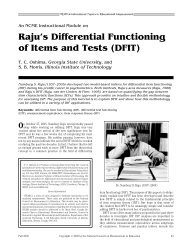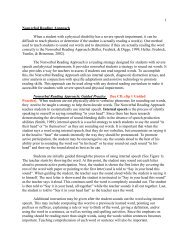Ch. 1 Biomechanics and Related Movement Disciplines
Ch. 1 Biomechanics and Related Movement Disciplines
Ch. 1 Biomechanics and Related Movement Disciplines
Create successful ePaper yourself
Turn your PDF publications into a flip-book with our unique Google optimized e-Paper software.
KH 3600 <strong>Biomechanics</strong><br />
<strong>Biomechanics</strong> <strong>and</strong> <strong>Related</strong> <strong>Movement</strong> <strong>Disciplines</strong>
<strong>Biomechanics</strong>: the physics (mechanics) of<br />
motion produced by biological systems.<br />
More specifically…a highly integrated field of<br />
study that examines the forces acting upon,<br />
within, <strong>and</strong> produced by a body.
Integrates biological characteristics with<br />
traditional mechanics.<br />
Mechanics: the branch of physics specifically<br />
concerned with the effect of forces <strong>and</strong> energy on<br />
the motion of bodies.
Mechanics<br />
Statics: the study of systems in a state of<br />
equilibrium.<br />
▪ At rest or in a constant state of motion.<br />
Dynamics: the study of systems in a state of<br />
accelerated/changing motion.
Kinematics: study or description of the spatial <strong>and</strong><br />
temporal characteristics of motion without regard<br />
to the causative forces.<br />
e.g., displacement <strong>and</strong> velocity<br />
Kinetics: study of forces that inhibit, cause,<br />
facilitate, or modify motion of a body.<br />
e.g., friction, gravity, <strong>and</strong> pressure
Example: A soccer player injures his foot<br />
while trying to outmaneuver an opponent,<br />
<strong>and</strong> possibly because he is too old to be<br />
playing soccer.<br />
▪ Kinematic perspective: How fast was the soccer player<br />
moving at the moment of injury?<br />
▪ Kinetic perspective: How much force was absorbed by<br />
the body when making a quick change in direction?
Outside of sport, biomechanists also examine<br />
more common human motions, such as<br />
walking.<br />
Example: Walking infant<br />
▪ Kinematic perspective: What is the length of the infant’s<br />
strides?<br />
▪ Kinetic perspective: Why does the infant walk in this<br />
manner?
Describe a movement in kinematic terms
<strong>Biomechanics</strong> is about movement:<br />
Exercise Physiology: movement is caused by<br />
contraction of skeletal muscle.<br />
Motor Control: mechanics used by the nervous<br />
system to control <strong>and</strong> coordinate movements.<br />
▪ Motor development<br />
▪ Motor learning
<strong>Biomechanics</strong> is about movement:<br />
Ergonomics: analyzing the work environment <strong>and</strong> human‐<br />
machine interaction.<br />
Physical therapy <strong>and</strong> sports medicine:<br />
prevention/treatment/rehabilitation from acute <strong>and</strong><br />
chronic injuries that result from human motion.<br />
Pedagogy <strong>and</strong> coaching: try to modify movement<br />
behaviors.<br />
Functional anatomy: no matter the movement‐related<br />
discipline, an in‐depth knowledge of the human body is a<br />
must.
Exercise requires the cooperation of all the<br />
body systems:<br />
Neurological system initiates muscle contraction<br />
to move the skeletal system.<br />
▪ Increased activity of the muscular system requires a<br />
large amount of energy (ATP) to be produced by the<br />
metabolic system.<br />
▪ To make ATP, oxygen <strong>and</strong> food fuel are needed.<br />
Transported within the body by our cardiovascular system.
The link between exercise physiology <strong>and</strong><br />
biomechanics is the neuromuscular system.<br />
Muscles are the metabolic machines that cause<br />
motion of the skeletal system.<br />
▪ Muscles are under the control of the nervous system.<br />
▪ Muscles are a kinetic factor that affects kinematic<br />
values.
For movement, muscles produce force, <strong>and</strong><br />
forces are the realm of kinetic analysis.<br />
As muscular strength changes, so do the<br />
kinematics of movement.
Motor = movement<br />
Motor behavior is defined by three sub‐<br />
areas:<br />
1. Motor control: how the nervous system controls<br />
coordinated skill performance.<br />
2. Motor development: how motor control changes<br />
over time.<br />
3. Motor learning: how humans learn motor skills.
Depending on the movement task, humans are<br />
believed to rely on one of two control systems:<br />
Open‐loop: movements that happen so quickly the brain<br />
doesn’t have time to receive feedback to influence the<br />
current performance.<br />
Closed‐loop: movements that can be changed during a<br />
performance as the brain receives sensory feedback from<br />
the eyes, ears, <strong>and</strong> proprioceptors throughout the body.
Coordinated movement must be controlled<br />
by the nervous system.<br />
In some cases the skills are open‐loop,<br />
whereas other skills are closed‐loop.<br />
The internal kinetics <strong>and</strong> resulting kinematics may<br />
vary.
From birth to advanced age, the body is in a<br />
state of dynamic state of change.<br />
The primary motor activities are evident at<br />
birth <strong>and</strong> are not voluntary.<br />
They are reflexive behaviors that are designed to<br />
gather information <strong>and</strong> protect the body.<br />
Voluntary motion begins only when the<br />
nervous <strong>and</strong> muscular systems are ready.
Kinematics <strong>and</strong> kinetics of all skills change<br />
with motor development:<br />
Until puberty, girls <strong>and</strong> boys differ very little in<br />
structure <strong>and</strong> physiology.<br />
<strong>Ch</strong>anges that occur during <strong>and</strong> after puberty can<br />
have positive <strong>and</strong> negative effects on athletic<br />
performance.<br />
▪ i.e., Michael Jordan was cut from his high school<br />
basketball team as a freshman, but he excelled once he<br />
adapted to his new size <strong>and</strong> strength.
The process of learning begins in the early stages of<br />
infancy.<br />
Early learning in movement is a trial‐<strong>and</strong>‐error<br />
process in which infants <strong>and</strong> toddlers attempt new<br />
activities.<br />
Motor learning takes into account the structural <strong>and</strong><br />
physiological changes through the lifespan, but<br />
focuses primarily on neurological aspects of<br />
attaining <strong>and</strong> retaining motor skills.
Ergonomics: a discipline concerned with<br />
interaction of humans <strong>and</strong> machines <strong>and</strong> with<br />
the factors that influence that interaction.<br />
Ergonomists attempt to improve the human‐<br />
machine system.
<strong>Biomechanics</strong> <strong>and</strong> ergonomics are so closely<br />
related that ergonomics is sometimes<br />
referred to as occupational biomechanics.<br />
Many kinetic factors affect work tasks: muscle<br />
forces, weight of equipment, vibrations, <strong>and</strong><br />
surface textures.
The kinematics of the work task can be<br />
analyzed by the ergonomists to estimate the<br />
effects of kinetic factors upon the human‐<br />
machine interface.<br />
Based upon the findings of biomechanical<br />
analysis, the ergonomists can then make<br />
informed decisions to improve the human‐<br />
machine system.
Biomechanical analysis can then be used to<br />
observe the resulting kinetic <strong>and</strong> kinematic<br />
changes to verify the effectiveness of the<br />
intervention.
Physical therapy: the field dedicated to preventing,<br />
evaluating, <strong>and</strong> treating movement abnormalities.<br />
Disordered movement may be caused by injury,<br />
disease, muscular imbalance, or congenital<br />
conditions.<br />
Abnormal motion at one joint is often associated<br />
with abnormal motion at another joint.
This abnormal motion (measured<br />
kinematically) is likely associated with<br />
abnormal forces acting upon that structure<br />
(kinetics), leading to further motion<br />
abnormality.<br />
Physical therapists must be familiar with<br />
biomechanical principles to properly<br />
recognize <strong>and</strong> diagnose the underlying cause<br />
of disordered movement.
Sports medicine: focuses on preventing <strong>and</strong><br />
immediately treating injuries that occur during<br />
sports <strong>and</strong> on rehabilitating athletes after such<br />
injuries.<br />
Preventing injury may require such methods as bracing<br />
<strong>and</strong> taping, both of which can affect normal human<br />
motion.<br />
<strong>Biomechanics</strong> can help the athletic trainer<br />
underst<strong>and</strong> the mechanism of injury.
The common objectives of quality teaching<br />
<strong>and</strong> coaching are to encourage learning <strong>and</strong><br />
enhance performance.<br />
Pedagogy in physical education <strong>and</strong> sport<br />
draws upon several fields to form the basis of<br />
scientific principles for teaching <strong>and</strong><br />
coaching:<br />
Psychology, sociology, motor behavior, anatomy<br />
<strong>and</strong> physiology, <strong>and</strong> biomechanics.
Adapted physical education: the process of<br />
teaching movement activities to children<br />
with disabilities.<br />
Underst<strong>and</strong>ing how the human body moves<br />
<strong>and</strong> learns enables the teacher to adapt<br />
movement activities that can help people<br />
with a variety of disabilities become<br />
competent, lifelong movers.
Defined: <strong>Biomechanics</strong>, Mechanics, Statics,<br />
Dynamics, Kinematics, Kinetics<br />
<strong>Biomechanics</strong> in linked with many other<br />
disciplines, but is the best <strong>and</strong> most<br />
important of all of them.
















